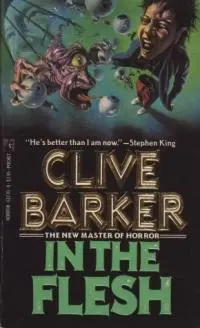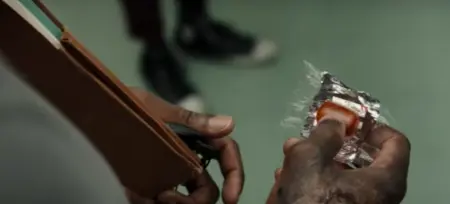We had Clive Barker’s short story:
Candyman
Then we had a trilogy of movies:
Candyman
Candyman
Candyman
And now, with Candyman (2021), we’ve said his name for the fifth time:
Candyman
Candyman tells us more than the story of a hook-handed, bee-infested slasher. It tells us about how we build monsters and how they take on a life of their own. And there’s no old-timey shit to get in the way, no questions about everyone eating psychedelic wheat, no academic musings about whether or not Clive Barker really existed. Everything from the first kernel of a story to the recent buzz is right here.
Spoilers
I’ll talk about Candyman (2021) without spoiling it until the final “Hot Take” section. The original short story and original Candyman trilogy are spoiled worse than raw chicken cutlets left in the trunk of your car in Texas heat.
The Forbidden
 When Clive Barker was 3, he saw a skydiver fall to his death at an airshow. When he was trying to make it as a writer and had trouble paying bills, he worked as a prostitute. (Some people will say writing is basically emotional prostitution. I don’t disagree.) And when he was a kid, his grandmother told him that there were bad men in public restrooms, waiting for a little boy to come along so they could cut off his penis. This penis-chopping story is the origin of “The Forbidden” and the seed of Candyman.
When Clive Barker was 3, he saw a skydiver fall to his death at an airshow. When he was trying to make it as a writer and had trouble paying bills, he worked as a prostitute. (Some people will say writing is basically emotional prostitution. I don’t disagree.) And when he was a kid, his grandmother told him that there were bad men in public restrooms, waiting for a little boy to come along so they could cut off his penis. This penis-chopping story is the origin of “The Forbidden” and the seed of Candyman.
Clive Barker’s Books of Blood started coming out in 1984, and they make up over 800 pages of creeps, gore, and magical terror. “The Forbidden,” from book 5 (In the Flesh) contains most of the critical DNA that would shape Candyman: Candyman is a legend who haunts an area of urban decay. The main character, Helen, is a white, upper-crust type cataloging graffiti for an academic project. Most of the major events of the first movie are here, but Candyman is without a backstory, and he haunts a housing project in the UK instead of being stateside. Oh, and he’s White.
The most stirring, most unique part of the original story is that Candyman suggests to Helen that by being his victim, her death will be important. She will live on as a cautionary tale, an urban legend herself. People will say, “That’s where that woman was killed.” Candyman wants Helen to consent to her own murder. He coerces, puts her into a somewhat hypnotized state, but he wants her to WANT to be his victim. It’s a creepy take on the slasher.
“The Forbidden" reminds readers that you and me can’t touch monsters, but if monsters want to touch us, we’re always within their reach.
Candyfans won’t find a lot new in “The Forbidden,” but it’s a quick read and only one of the many fantastic stories in Books of Blood.
Candyman (1992)
I am the writing on the wall, the whisper in the classroom. Without these things, I am nothing. So now, I must shed innocent blood.
From the opening shots to the score to TONY FUCKING TODD to the disgusting visual of Candyman’s wounds crusting over the fur on his coat cuffs, Candyman is just about perfect.
The movie stays pretty true to the short story, but unusually for a book-to-movie transition, the movie has more backstory and depth than the original story, and a few of the additions are the bee’s knees.
Candyman was Daniel Robitaille, a portrait painter, the son of a slave. He and one of his subjects, the daughter of a wealthy White man, fell in love, had a child, and a lynch mob cut off Robitaille’s hand, jammed a hook in, and smeared him with honey to attract bees, who stung him to death. Now he haunts Chicago’s Cabrini-Green housing project.
In the movie, Helen wrecks Candyman’s reputation, people stop believing in him, and he tells her that she’s forced him to kill again so that people believe. A little different from the story, but still a unique slasher motivation. There's also a more sexual/romantic thing between Candyman and Helen going on, which (I know, this sounds like it can't be true) was still fairly taboo on screens in 1992. The Bodyguard with Kevin Costner and Whitney Houston also came out that same year, and its depiction of a romance between a Black character and a White character was the source of quite a bit of talk at the time.
Plot description doesn’t do the movie justice, so let’s skip it. Stuff happens, Helen thwarts the Candyman, kind of, but not really, and we get a little twist at the end. It’s a solid horror movie with practical effects, some disgusting gore, and Tony Todd with a faceful of actual, live bees.
Of course, we can't talk about Candyman without talking about race. And we can't talk about that without talking about Cabrini-Green.
Cabrini-Green
I’m not here to explain why housing projects don’t work and how to fix them. Looking to me for an intelligent take on this stuff is about as smart as saying “Candyman” in the mirror 5 times. I just want to give you a little history of Cabrini-Green because without it, Candyman might look totally different.
Cabrini-Green was a Chicago housing project that started getting packed in the early 40s. Post-WWII, a bunch of factories shut down in Chicago, leaving the city and residents in a tough financial spot, and Cabrini-Green suffered hard. The green space was paved over, apartments were poorly constructed and barely maintained, and if an apartment was burned or badly damaged, it’d just be boarded over and left.
By the 80’s, Cabrini-Green had a gang problem that spilled over onto all the residents. In the first 3 months of 1981, Cabrini-Green has 37 shootings, resulting in 11 deaths. The insides of the buildings are full of graffiti, malfunctioning elevators, and the garbage was known to clog the chutes up to the 15th floor.
A couple brutal crimes committed against children (Girl X, 9 years old, and Dantrell Davis, 7) got national attention, and between them, the violence, and a Chicago mayor's failed attempt to reside at Cabrini-Green, Cabrini-Green’s reputation was cemented.
![]()
photo
You know that obnoxious shit where someone says, “In this movie, it’s like L.A. is a character, too”? In Candyman, Cabrini-Green makes the story, it’s a very alive setting. But it’s not a character. It’s a force of nature. If you’ve never watched the first movie, at the very least, check out the sequences filmed in Cabrini-Green.
More important than Cabrini-Green as backdrop, the move to Cabrini-Green is what prompted director Bernard Rose's decision to make Candyman Black.
Another Chicago housing project (ABLA, not Cabrini-Green) was the location of a particularly awful murder that inspired some of the Candyman story as well. Between the mirrored medicine cabinet in Apartment A and the same cabinet in Apartment B was thin drywall and a pipe chase, which meant it was easy to come through the wall, “through the mirror,” from one apartment to another. Which is how Ruthie-May McCoy, 52, was murdered.
Without Chicago housing projects and Cabrini-Green, there might be a Candyman, but he might not be as legendary, and he might not be Black.
A current thread about Candyman (1992) will tell you the housing projects were exploited to make a terrifying movie which made people afraid of the projects and painted residents with a broad, horrible brush.
In an article in TIME, different Candyman creators, residents of Cabrini-Green and others who grew up in Chicago shared differing opinions:
Candyman (2021) director Nia DaCosta:
The original film definitely fed into a fear of the Black community, and the Black man in particular. I didn’t want to do this approach of, ‘Oh, god, this terrible place where terrible things are happening, because these brutes are living here.’ This is a community that was chronically underserved for a very long time.
Teddy Williams, who lived in Cabrini-Green:
It was like a little village: everybody knew everybody. There was gang activity, but also a lot of structure amongst others that weren’t involved: after school programs where they’d have games, trampolines, screen painting, quilt sewing. We put on dance routines and dressed up like the zombies in the Thriller video...I think the community was mostly okay with the movie, because it put us on the map again. The only thing we would talk about is that Candyman could never live over here and do what he was doing, because he would get f-cked up.
J. Nichole Brooks:
The folklore could actually save your life. For example, ‘Do not go under the viaduct west of Comiskey Park unless there’s a White Sox Game.’ You grew up thinking the boogie man was all over Chicago—and for the most part, it was true.
There’s an important-but-underrated moment in Candyman (1992) when Helen leaves the hallway of Cabrini-Green and enters Anne-Marie’s apartment. We move from a dark, filthy hallway to a bright, small apartment that Anne-Marie is clearly doing her best to make a home. Her apartment is decorated just like the apartments of people I knew, moms in rural, white Colorado.

Some interpretations are going to be that a white filmmaker used Cabrini-Green to up the production value and scare factor of his movie. Others will say that the depiction wasn't entirely wrong, and why shouldn't there be a modern ghost story in Cabrini-Green? The only stance I want to take is that Candyman is a subjective piece of art, and I don't really think there is a "correct" and "incorrect" way to interpret something like that. Different people will take away different things. To me, this is the sign of a complicated, complex idea, and I choose to make room for those sorts of things in my life.
Candyman II: Farewell to the Flesh
Legend has it that the first Candyman II script was similar to Candyman, but it focused on gender instead of race. However, the studio decided this was “too risky” and settled for a boring slasher.
Candyman II takes the trope-y horror route of magical talismans in service of defeating the Candyman once and for all, a definite downgrade from the terror and mystery of the first movie.
The biggest change to the Candyman lore is the change to say Daniel Robitaille was born a slave. Virginia Madsen, Helen in the first movie:
They made the Candyman into a slave which was terrible because the Candyman was educated and raised as a free man. [Candyman director] Bernie wanted to make him like an African American Dracula which I think it was so appealing to the African American community because they finally had their own Dracula. The Candyman was a poet and smart. He wasn't really a monster. He was sort of that classical figure.
Candyman II isn’t a total garbage movie. It just doesn’t make good use of the established story, and it doesn’t have a new hook, either. It's Candyman Lite, which nobody wanted then and nobody needs now.
Candyman III: Day of the Dead
Candyman III opens with a Baywatch star walking around in her underwear. That tells you most of what you need to know about it.

The barely-clad star, Donna D’Errico, plays Daniel Robitaille’s great-great-granddaughter. She wants people to remember Daniel Robitaille as an artist, a painter, and a gentle soul as opposed to the murderous Candyman of legend, which is...actually a pretty good sequel premise. It could go a number of new, interesting ways. Or you could do what the makers of Candyman III did and abandon the premise inside of 10 minutes so Candyman can start hacking people apart.
We have a comically evil police officer who is very thorough in covering the asshole bases (drunk, racist, sex pest...), a magical abuela who explains how to defeat Candyman LIKE THREE TIMES, and a pretty awful scene where Candyman is sort of having ghost sex with his own great-great-granddaughter, which, maybe we're supposed to forget they're related?
Tony Todd is tragically wasted. As he is in most movies, but in this one, it really stings. You have Tony Todd on set, someone has to do some voiceover narration, and SOMEHOW you threw narration duties to Donna D'Errico?! Tony Todd should be narrating audiobooks. He should be the voice that tells you not to stand between the doors on the train. He should be a Waze narration option. If you have the chance to get Tony Todd to narrate anything, I don't care if it's a cereal box, you do it.
At this point, Candyman is nothing more than a boring slasher, terrorizing mostly random people until some White woman can do some sort of magic and banish him to the nether realm for the few years it takes to make a sequel.
Candyman deserved to go out with something better than this.
Canceled Fourth Movie
Supposedly there were talks about a fourth Candyman film, and Tony Todd was heavily involved. The story would take place during a confining New England blizzard, and Candyman’s backstory would involve him being a former professor at a women’s college. But the fourth movie never got off the ground, possibly because of rights issues, possibly because Candyman III. Which is too bad because it sounds like a revamp and a new, interesting direction.
Candyman (2021)
New Candyman (that’s what I’ll call it for clarity) is far from the best Candyman movie, but it’s the hands(hooks)-down best Candyman sequel.
New Candyman follows McCoy, a Black, male painter, going through the Candyman mythos, similar to Helen in the first movie. Most of the events of the first movie are canonical in this one and play out in a way fans of the original will appreciate and newbies will understand. McCoy’s march through the Candyman lore doesn’t feel super unique, but it’s not insulting, nor is it narrated by a Baywatch star, so points for making good choices.
Wait, shit, Yahya Abdul-Mateen II (McCoy) was in the 2017 Baywatch reboot. That has to be the most bizarre, unlikely Candyman connection yet.
There are some solid horror sequences, and the final form of Candyman makes for a pretty haunting visual. There’s a chilling scene in an elevator, and there’s some ever-progressing body horror that’s nothing terribly new to gorehounds, but it’ll shock the portion of the audience who occasionally dip into horror but probably didn’t watch, I don’t know, Psycho Goreman (you’re missing out). The sequences with paper dolls are wonderful, though they're underused.

When we get into some deeper themes, the movie stumbles. Director Nia DaCosta, referring to a portion of the movie that discusses the real-life tragedy of Girl X at Cabrini-Green:
That line of exploiting racial pain in order to make art for White people was really what that was all about...But also struggling with your own history, and how as an artist — or a person — do you reconcile it?
When DaCosta is making THAT movie, the story about art and commerce and selling pain, it works. And the Candyman story works, though not as well. The problem is that the two stories are almost completely separate until the movie's final 10 minutes, and the rushed attempt to bring them together at the very end just doesn't work. You know how you can put a scoop of protein powder in a glass of water, and no matter how much you stir, you’ve still got chunks? That’s kind of how New Candyman feels: You can swallow it, but you’ll have to chew a little more than you’d like.
I'm not a believer that the last 5% of something is the make or break. New Candyman isn’t perfect, but it’s worth your time. Ignore the online chatter about it. It’s not the greatest film ever made, and it’s not trash, either. You won't solve racial inequality by seeing it, but you won't come away a worse person, either.
I want to leave you with a rating, like thumbs up or stars or whatever. How about this new ratings system: “Is it worth risking COVID to see this in the theater?” I’m giving that a "Hell, no." But it’s worth the price of streaming at home before some asshat ruins it for you.
The Candyman Legacy aka Pete’s Hot Take
What review of a movie would be complete without a hot take? Reminder, this portion contains spoilers for Candyman 2021.

The ending is kind of a hot mess. Burke, who was at the laundromat, serves as a sort of “Magical Black Man” who somehow knew everything about how Candyman worked, how to make his own Candyman, and how to set that Candyman to target specific people and become a spirit of Black empowerment and vengeance. It didn’t really make a lot of sense, it was weird that things happened exactly as Burke said they would, the switch to our POV character being McCoy’s ex instead of McCoy was rough because we barely knew her, and most importantly, the cops shot McCoy, however it was murder-by-proxy as orchestrated by Burke. Cops pulled the trigger, but Burke set everything in motion, created the situation very intentionally, and it would seem he’s more than a little responsible for McCoy’s death.
In New Candyman, McCoy is not a monster. He’s as much a victim as anyone else. A vessel set to a task, possibly against his will. I don't think this will make him iconic (Yahya Abdul-Mateen II spends most of the movie zombified, which is an unfortunate use of the guy).
Sherman, the Candyman McCoy encounters throughout the film, isn’t a monster, either. He’s a victim, he doesn’t speak, and it’s unclear whether he has any agency or free will. You only see him in brief flashes. He's not visible enough to be an icon.
Burke is the villain, but he's not iconic. He’s a Renfield. Nobody writes Renfield's name on the wall. Nobody whispers his name.
I understand that what I'm saying here has been said by others. Here's the hot part, the reason it matters:
We like our villains in horror. They’re what make horror unique and interesting. If someone wears a t-shirt at a horror con, that t-shirt will not feature Heather Langenkamp or Corey Feldman or Neve Campbell. It’ll feature Freddy or Jason or...Scream guy. Scream? Are we just calling him Scream? Even when you've got an arguably iconic hero from horror, Ellen Ripley or Laurie Strode, they just can't compare to their xenomorph or Michael Myers counterparts.
In horror, the villains, the monsters, are what bring us to the theaters, and what bring us (regrettably in the case of Candyman III) to the sequels. Candyman, Daniel Robitaille, is the iconic Candyman character and one of the only Black horror icons. He's Black Dracula. He brought us to the new movie. He transcended the movie and really WAS "the writing on the wall, the whisper in the classroom." When I was a kid, "Candyman" was the name you dared other kids to say in the mirror, right up there with Bloody Mary.
In transforming the Candyman from Daniel Robitaille’s iconic monster into an anti-hero, a symbol of justice, New Candyman leaves us with a message, but as iconic characters go, we're left empty-handed.
The original movie works like a razor blade wrapped in a chocolate bar. You take a big bite, you watch it for the iconic, scary Candyman, you go for the horror, and you can’t help but be affected when you see Anne-Marie's apartment or the fear in Jake's eyes when he talks about Candyman. You bite, you chew, and you get cut deep because you were expecting nougat (whatever the hell THAT is), not a blade. You were expecting a slasher, and you got a lot more.
Instead of concealing the blade in chocolate, New Candyman's razor trap feels like the candy that drops from nowhere in the movie's mirrored elevator scene, a piece of hard candy with a razorblade clearly sticking out of the top. It'll catch your finger, but nobody is putting that in their mouth. It'll cut you, but it's not as affecting as the thought of biting down hard on a blade.
Without that candy to conceal the blade, without that enticement, I don’t know that the viewer bites as hard or gets cut the same way. Without the iconic bad guy, without the Black Dracula, I don't know if the movie's hook pierces as deep. I don't know if the wounds last as long. I don't know that this newest Candyman will inspire kids sleeping over at each other's houses to dare each other.
Go ahead. Say his name.

Last Call
I just want to put in a plug for my charity of choice, Off The Street Club in Chicago's West Garfield Park. Chicago holds a special place in my heart and family history, and if any iteration of Candyman left you wanting to help Chicago out, or to help real people who could really use it, consider Off The Street Club.
Get In the Flesh by Clive Barker at Bookshop or Amazon
Get High Rise Stories: Voices from Chicago Public Housing by Audrey Petty at Bookshop or Amazon

About the author
Peter Derk lives, writes, and works in Colorado. Buy him a drink and he'll talk books all day. Buy him two and he'll be happy to tell you about the horrors of being responsible for a public restroom.









